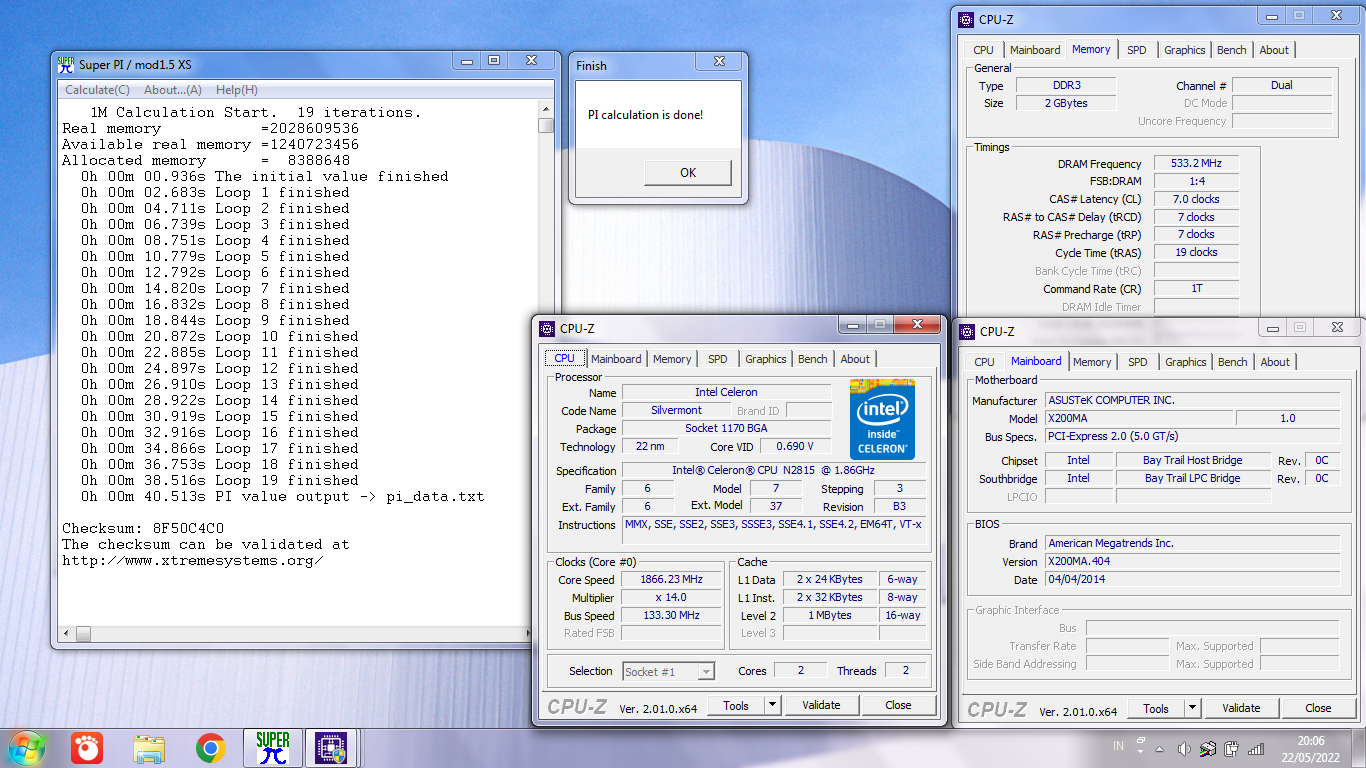SuperPi - 1M score 40sec 513ms with a Celeron N2815
Thursday, 01 January 1970 07:00 | Update at null
Media Gallery
Screenshot

Device, Setup, etc

URL
https://hwbot.org/submission/5001751https://www.facebook.com/hakimnu.id/posts/3290640794501894
Information Detail
Hardware: Intel Celeron N2815
Specs:CPUID : Intel(R) Celeron(R) CPU N2815 @ 1.86GHz
Architecture : x86
Codename : Silvermount
L3 Cache : -
Clock : 1.86GHz - 2.13GHz
Core/Thread : 2/2
TDP : 7.5W
Technology : 22nm
Socket : FCBGA1170
IGPU : Intel HD Graphics Bay Trail for Z3700 (Mobile)
See more specification...
Software: SuperPi - 1M
Score: 40sec 513ms
About: SuperPi - 1MSuperPi - 1M is one of the classic and popular benchmarks used to measure single-thread CPU performance by calculating the number π (pi) to 1 million decimal places. This benchmark has long been a favorite benchmark among tech enthusiasts, overclockers, and hardware testers due to its simplicity, speed, and accuracy in directly assessing processor performance.
In SuperPi 1M testing, only one CPU core is used to complete the calculation as quickly as possible. This makes it ideal for assessing the single-core capability of a CPU, especially in scenarios where single-core performance remains highly relevant, such as in lightweight applications, gaming, or everyday use.
Despite its simplicity, SuperPi 1M is highly sensitive to clock speed, memory latency, and processor architecture efficiency. As a result, this benchmark is often used as a standard in overclocking competitions, as even small differences in system configuration can lead to significantly different execution times.
Features and Advantages:
- Calculates 1 million digits of the number π (pi) with precision.
- Emphasizes the single-thread performance of the processor.
- Runs quickly, ideal for repeated testing.
- Suitable for comparing CPU architecture efficiency.
- Still widely used in the global overclocking community.
Despite the availability of many modern benchmarks, SuperPi 1M remains a significant tool in CPU testing due to its direct representation of basic computational performance. This benchmark is also lightweight and compatible with nearly all Windows versions, making it a practical tool for quick system evaluation.
The Intel Celeron N2815 is a power-efficient processor released in 2013 as part of the Bay Trail-M family, aimed at entry-level laptops and lightweight computing devices. It has 2 cores and 2 threads with a base speed of 1.86 GHz that can increase to 2.13 GHz thanks to Intel Burst Performance technology. Built using a 22nm fabrication process, the N2815 comes with a TDP of only 7.5 watts, making it one of Intel's most efficient processors in terms of power consumption for the low-end class. This makes it very suitable for portable devices such as netbooks or mini laptops that prioritize battery life over high performance.
On the graphics side, the Intel Celeron N2815 is equipped with an integrated Intel HD Graphics (Bay Trail) GPU that runs at a base frequency of 313 MHz and can reach up to 756 MHz under certain conditions. This GPU is capable enough to run desktop displays smoothly, and supports 720p video playback. However, for heavy graphics tasks such as playing modern 3D games, video editing, or graphic design, this GPU is clearly not capable. Its use is more suitable for everyday computing such as opening documents, browsing the internet, playing standard videos, and running light office applications.
In terms of overall performance, the Celeron N2815 is sufficient for running light operating systems such as Windows 7 or light-based Linux distributions such as Lubuntu or Linux Mint XFCE. However, due to its simple architecture and low single-threaded performance, users may experience limitations when running multiple applications at once or when opening software that requires higher computing power. In tests using an Asus X200MA laptop with 2GB DDR3 dual channel RAM and Windows 7 operating system, performance was good enough for basic use, although it was slow when running modern applications or multitasking.
Overall, the Intel Celeron N2815 is a decent processor for light computing needs with low power consumption and an economical price, but it is not recommended for heavy productivity tasks or long-term use on modern operating systems.
Hardware Detail:
Device: Asus X200MA
RAM: 2GB Dual Channel
OS: Windows 7
* Not Avaiable
